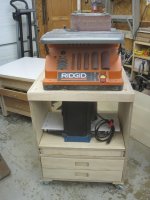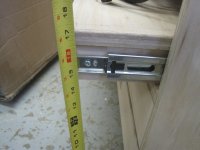juststartingout
Member
- Joined
- Mar 23, 2014
- Messages
- 57
Hi All,
I have a small hobbyist shop where my car currently lives and am looking to organize and maximize floor space. I already have a flip top stand for my planer and ridgid spindle sander. It was housing my miter saw but I decided to swap the sander and saw so I could build a miter saw station.
and am looking to organize and maximize floor space. I already have a flip top stand for my planer and ridgid spindle sander. It was housing my miter saw but I decided to swap the sander and saw so I could build a miter saw station.
ANY WAY...
I am debating on using the flip top as it feels like more of a pain than it should be. It was one of my first shop projects and the holes for the lock pins are tighter than I'd like.
So I was debating on scraping the fliptop for a nesting rolling stand, where the sander would be on the outer stand and the planer would be nested underneath on wheels. This feels like it would maximize space and I could easily be using both tools if the need ever arises without having to flip a table?
thoughts?
Oscar
I have a small hobbyist shop where my car currently lives
ANY WAY...
I am debating on using the flip top as it feels like more of a pain than it should be. It was one of my first shop projects and the holes for the lock pins are tighter than I'd like.
So I was debating on scraping the fliptop for a nesting rolling stand, where the sander would be on the outer stand and the planer would be nested underneath on wheels. This feels like it would maximize space and I could easily be using both tools if the need ever arises without having to flip a table?
thoughts?
Oscar


